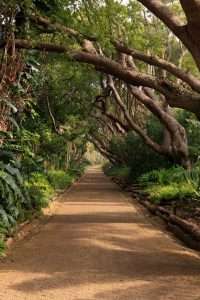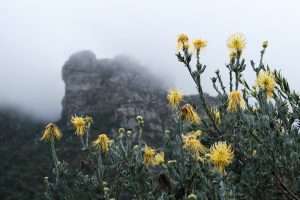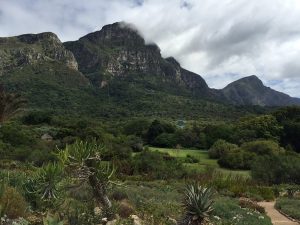Nestled at the base of Cape Town’s iconic Table Mountain, the Cape Town Botanical Gardens serve as a lush sanctuary of biodiversity and history, offering visitors a unique blend of natural beauty and scientific significance. Established as one of South Africa’s first formal gardens, these botanical grounds have flourished into a globally recognised hub for plant conservation and research. With winding paths, diverse plant collections, and stunning views, the gardens showcase the vibrant flora of the region, especially its prized fynbos—a plant kingdom found nowhere else on Earth.
Botanical gardens have always held a special place in South Africa’s history, intertwining with the country’s journey through colonialism, apartheid, and post-apartheid renewal. Initially designed to cultivate exotic species and sustain European settlers, the Cape Town Botanical Gardens have evolved into a beacon of environmental stewardship. Today, they play a critical role in educating the public on South Africa’s extraordinary plant diversity, while serving as a global center for research on climate change, biodiversity conservation, and sustainable ecosystems. Their importance in preserving indigenous flora cannot be overstated, as they contribute to both the country’s ecological heritage and its future.

Photo by Piat Van Zyl
This historic institution stands as a testament to South Africa’s dedication to its natural world, evolving from a colonial utility into a symbol of pride, scientific achievement, and environmental activism. Through every phase of its growth, the Cape Town Botanical Gardens have remained a focal point for not just flora but the cultural and scientific development of South Africa.
The Early Beginnings (1652–1800)
The origins of the Kirstenbosch National Botanical Garden trace back to the early days of Cape Town’s establishment as a strategic refreshment station by the Dutch East India Company (VOC) in 1652. Although Kirstenbosch itself was not formally established until 1913, the concept of a botanical garden in the region stems from this period, where the groundwork was laid for horticultural and botanical exploration. The early gardens were practical, serving the needs of European settlers and maritime trade by growing essential crops and medicinal plants to sustain passing ships on their long voyages to the East Indies.
Founding of the Company Gardens
Jan van Riebeeck, the first VOC commander of the Cape Colony, played a pivotal role in introducing formal horticulture to the region. Upon his arrival in 1652, van Riebeeck quickly realised the need to cultivate crops in the Cape to provide food and medicinal plants for sailors suffering from scurvy and other ailments. Though not a botanical garden in the modern sense, the foundations of organised cultivation and plant management began under his leadership in the Company’s Gardens, located near the present-day Parliament in Cape Town.
This early effort focused primarily on agricultural production rather than botanical research or conservation. However, it laid the foundations for a growing awareness of the local environment, and it initiated the importation and cultivation of a variety of exotic species that would later play a role in botanical studies. Over time, Cape Town became known for its rich and diverse flora, sparking interest from botanists and collectors worldwide.
Influence of the Dutch East India Company (VOC)
The Dutch East India Company was instrumental in establishing horticultural practices at the Cape. As the VOC extended its trade routes across the globe, Cape Town’s strategic location made it a vital stopover. The Company’s Gardens, developed as part of the colony, not only sustained travelers but also acted as a site for experimentation with agricultural imports. The VOC imported seeds and plants from all corners of its empire, introducing European, Asian, and tropical crops that would shape the landscape for years to come.
The early focus on agriculture and medicinal plants grew alongside an emerging interest in the local flora. Cape Town’s unique environment, nestled between mountain ranges and coastal plains, provided fertile ground for the exploration of indigenous species. As the Company’s Gardens expanded, so too did the vision of turning the Cape into a center of botanical knowledge—a dream that would eventually culminate in the creation of the Kirstenbosch Gardens.
Key Figures in the Establishment, Including Jan van Riebeeck
Jan van Riebeeck, as the first governor, is credited with initiating the earliest efforts to cultivate the land at the Cape. While his primary concern was to ensure the survival of the colony, van Riebeeck’s contribution to horticultural development cannot be overstated. His efforts paved the way for the later establishment of more formal botanical collections in the region.
Although it would take years for Kirstenbosch to officially come into existence, these early pioneers laid the groundwork by recognising the importance of South Africa’s unique biodiversity. By 1800, the groundwork for formal botanical research had been laid, and Cape Town was already establishing itself as a center of botanical curiosity. The foundations built during these early years would be crucial for the later development of Kirstenbosch as a formal botanical institution.

Photo by op23
Colonial Expansion and Development (1800–1900)
The 19th century marked a significant era of transformation for the Cape and its botanical landscape. With the British occupation of the Cape Colony in the early 1800s, new influences, practices, and resources reshaped the development of horticulture and botanical research in the region. Although Kirstenbosch was not officially established until 1913, the colonial expansion of the 19th century set the stage for its eventual creation, particularly through the cultivation and study of exotic and indigenous plant species, as well as the rise of formal botanical research.
British Influence on the Gardens
Under British rule, the Cape’s strategic importance as a colonial outpost grew, and with it, the significance of its botanical endeavors. The British brought with them a keen interest in horticulture, and Cape Town’s role as a stopover for ships meant that the region’s gardens continued to develop as a vital part of the colony’s infrastructure. The British established several formal gardens and promoted the cultivation of plants both for food and ornamental purposes, continuing the Dutch legacy but with a greater emphasis on scientific inquiry and aesthetic appeal.
The Company’s Gardens, which had been founded under Dutch rule, flourished under British administration. It became a symbol of colonial power and botanical wealth, serving both as a resource for the burgeoning settler population and as a place of leisure for British officials and visitors. More importantly, the British brought with them a global botanical network, linking Cape Town to other botanical gardens and institutions across the British Empire. This interconnectedness would play a key role in promoting South Africa’s unique flora to the world.
Role in Global Plant Trade and Exotic Species
During the 19th century, Cape Town became a critical hub for the global plant trade, with ships transporting plants and seeds to and from various parts of the British Empire. The Cape’s mild Mediterranean climate made it ideal for growing a wide range of species, and its various botanical gardens became testing grounds for exotic plants from Europe, Asia, and the Americas. Plants like oaks, pines, and various fruit-bearing trees were introduced, reshaping the Cape’s landscape and agricultural possibilities.
Conversely, Cape Town’s indigenous plants also became sought-after commodities in the global plant trade. Botanists and explorers from Europe were fascinated by the unique flora of the Cape Floristic Region, particularly the fynbos biome, which included a vast array of species not found anywhere else on Earth. The Cape’s plants, particularly its iconic proteas, ericas, and restios, were exported to botanical gardens across Europe, where they were studied and admired for their uniqueness.
This exchange of plant species had lasting ecological impacts, both positive and negative. While it introduced valuable agricultural crops and ornamental plants to the Cape, it also led to the spread of invasive species that would pose a threat to local ecosystems. This period of plant trade, however, cemented the Cape’s reputation as a botanical hotspot of global significance.
Early Botanical Research Efforts
As British influence grew, so too did the emphasis on formal botanical research at the Cape. In the 19th century, scientific inquiry into the flora of the region began to take root, spurred by the growing recognition of the Cape’s extraordinary biodiversity. The arrival of prominent British botanists and naturalists, such as William Burchell and Sir Joseph Hooker, brought renewed interest in cataloging and understanding the unique plant life of South Africa.
William Burchell, an explorer and naturalist, undertook extensive botanical expeditions across southern Africa during the early 1800s, collecting thousands of plant specimens that would later contribute to scientific knowledge of the region’s flora. His collections, along with those of other early botanists, became critical for the formal establishment of botanical institutions in South Africa.
Sir Joseph Hooker, a prominent botanist and director of the Royal Botanic Gardens at Kew, played a key role in linking the Cape’s botanical efforts with those of Britain. His interest in the Cape’s flora helped raise international awareness of the region’s unique plant life and underscored the need for formal botanical gardens and research institutions in South Africa.
While botanical research during this period was still in its infancy, the seeds of scientific inquiry were sown, and the growing interest in South African flora led to the eventual formalisation of Kirstenbosch as a center for plant research and conservation in the early 20th century. By the end of the 19th century, the groundwork had been laid for the Cape to become a leader in botanical science, with a growing network of researchers and institutions dedicated to understanding and preserving its rich plant heritage.
This period of colonial expansion and botanical exploration, while often driven by the motives of empire, was instrumental in setting the stage for the establishment of Kirstenbosch and the broader South African National Biodiversity Institute (SANBI), which continues to play a vital role in plant conservation and research today.

The Foundation of the Gardens (1900–1948)
The early 20th century heralded the formal establishment of the Kirstenbosch National Botanical Garden, an institution that would grow to become one of the most celebrated botanical gardens in the world. Although Cape Town had long been a hub of horticultural activity, it was not until 1913 that a dedicated botanical garden was founded with a clear mission: to conserve and study the unique flora of South Africa, particularly the indigenous species of the Cape Floristic Region. This period was pivotal in the creation of Kirstenbosch and its transformation into a world-class center for research, conservation, and education.
The Visionary Behind Kirstenbosch: Harold Pearson
The establishment of Kirstenbosch owes much to the vision and determination of Harold Pearson, an English botanist who arrived in South Africa in 1903 to take up a professorship at the South African College (now the University of Cape Town). Pearson was deeply impressed by the rich biodiversity of the Cape, particularly its fynbos vegetation, and was alarmed by the widespread destruction of this unique flora due to agriculture, urbanisation, and invasive species.
Recognising the urgent need for conservation, Pearson envisioned a botanical garden that would not only preserve South Africa’s indigenous plant life but also serve as a center for scientific research. His passion and tireless advocacy for the cause laid the foundation for what would become Kirstenbosch. In 1913, after years of campaigning, Pearson’s dream was realised when the government allocated a 528-hectare portion of land on the eastern slopes of Table Mountain for the establishment of the botanical garden.
The Founding of Kirstenbosch in 1913
Kirstenbosch was formally founded in 1913 under the stewardship of Harold Pearson, who was appointed as the garden’s first director. The land chosen for the garden had previously been part of a farm, and much of it was in a state of neglect, overrun with invasive species and plagued by erosion. Despite the challenges, Pearson saw the potential in the site’s natural beauty and its strategic location within the Cape Floristic Region, one of the most biologically diverse areas in the world.
Pearson and his small team of gardeners and assistants began the monumental task of transforming the land into a world-class botanical garden. Their primary mission was to focus on the conservation and study of indigenous flora, particularly the fynbos vegetation that was under threat. Unlike many botanical gardens of the time, which focused primarily on the cultivation of exotic species, Kirstenbosch was unique in its dedication to preserving the local plant life of South Africa.
Early Challenges and Achievements
The early years of Kirstenbosch’s existence were fraught with challenges. Funding was limited, and much of the land was in poor condition, requiring extensive restoration efforts. Pearson and his team worked tirelessly to remove invasive species, stabilise the soil, and create the garden’s first formal plant collections. Despite these difficulties, progress was made, and by the 1920s, Kirstenbosch was beginning to establish itself as a major center for botanical research and conservation.
One of the early achievements of the garden was the creation of the Protea Garden, which showcased South Africa’s national flower, the King Protea, and other indigenous species. This collection became one of the highlights of Kirstenbosch and helped raise awareness of the importance of South Africa’s unique plant life. The garden also played a critical role in propagating and distributing indigenous plants to other botanical gardens around the world, further cementing its reputation as a leader in plant conservation.
The Role of the Botanical Society of South Africa
In 1913, the same year that Kirstenbosch was founded, the Botanical Society of South Africa was established to support the development and promotion of the garden. The society played a crucial role in securing funding and public support for Kirstenbosch, helping to ensure its long-term survival. The collaboration between the Botanical Society and the garden’s management was essential in fostering a sense of public ownership and pride in the project, which contributed to its early success.
Harold Pearson’s Legacy and Passing
Tragically, Harold Pearson did not live to see the full fruition of his vision for Kirstenbosch. He passed away in 1916, just three years after the garden’s founding. However, his legacy lived on, and his successors continued to build on the foundation he had laid. Pearson’s work had not only created a haven for South Africa’s indigenous flora but also set a precedent for botanical conservation worldwide.
In honor of his contributions, a bronze bust of Pearson was erected in the garden, and it remains a prominent feature of Kirstenbosch to this day. His visionary leadership and passion for South Africa’s plant life were the driving forces behind the creation of the Cape Town Botanical Gardens, and his influence continues to be felt in the garden’s ongoing conservation and research efforts.
The Gardens in the Era of Apartheid (1948–1994)
The era of apartheid, from 1948 to 1994, was a time of profound political, social, and cultural upheaval in South Africa. Kirstenbosch National Botanical Garden, like many institutions, was not immune to the impacts of the apartheid regime, which instituted strict racial segregation across all areas of public life. While the garden continued to be a center for botanical research and conservation, its public accessibility and internal operations were deeply affected by the policies of apartheid. Nonetheless, during this challenging period, Kirstenbosch managed to preserve its mission of protecting South Africa’s unique flora and, remarkably, continued to gain international recognition for its scientific work.
How Apartheid Affected Public and Scientific Community’s Access
Under apartheid law, public spaces, including parks, beaches, and gardens, were racially segregated. Kirstenbosch, as a public garden, was no exception. Access to the garden was largely restricted to white South Africans, with Black, Coloured, and Indian citizens being either entirely prohibited or allowed limited access under highly regulated conditions. This exclusion of the majority of the country’s population from one of its most significant natural landmarks highlighted the broader injustices of apartheid.
Despite these restrictions, Kirstenbosch remained a place of scientific research. However, access to educational and research opportunities was similarly limited for non-white South Africans, who faced significant barriers to entering the scientific community. The apartheid regime also discouraged international collaboration with South African institutions, further isolating the country’s scientific work.
Nevertheless, some South African scientists, regardless of race, persisted in their efforts to study and preserve the nation’s biodiversity. For many researchers working at Kirstenbosch, this era of segregation was a painful contradiction, as their work was dedicated to the conservation of nature and promoting global collaboration in botany, while their nation was deeply divided by discriminatory laws.
Preservation Efforts and Challenges During This Period
Despite the political turmoil and isolation of the apartheid years, Kirstenbosch continued its work in botanical conservation, research, and education. The garden remained dedicated to its mission of preserving South Africa’s unique flora, especially the rich biodiversity of the fynbos biome, which was recognised as one of the most biologically diverse areas on the planet.
However, preserving South Africa’s flora during this period was not without its challenges. Apartheid policies favored the economic exploitation of natural resources, often at the expense of environmental conservation. Agricultural expansion, industrial development, and urbanisation, particularly in the Cape Floristic Region, posed significant threats to the indigenous plant life that Kirstenbosch was committed to protecting. The garden’s staff had to fight against the encroachment of these developments, advocating for the protection of endangered species and habitats.
One of the key areas of focus during this time was the fight against invasive species, particularly those that had been introduced during earlier colonial periods. Invasive plants like wattles, pines, and hakeas posed a severe threat to the indigenous fynbos vegetation, and Kirstenbosch played a leading role in efforts to control and eradicate these species. Despite the limited resources and political challenges of the time, the garden’s conservationists worked tirelessly to protect South Africa’s plant diversity.
Notable Research and Global Recognition
Even during the dark days of apartheid, Kirstenbosch continued to gain global recognition for its contributions to botanical science. The garden remained a world leader in the study of South African flora, particularly in areas such as plant taxonomy, ecology, and conservation. Researchers at Kirstenbosch made significant contributions to the understanding of the country’s unique plant life, particularly its rich diversity of Proteaceae (the family to which the King Protea, South Africa’s national flower, belongs).
In 1951, the South African National Biodiversity Institute (SANBI) was established, with Kirstenbosch as one of its flagship institutions. This formalized the garden’s role in national and international botanical research, and it became a center for scientific studies on biodiversity, ecology, and plant conservation. SANBI’s establishment was a significant milestone, ensuring that Kirstenbosch had the resources and institutional backing to continue its critical work, despite the broader political challenges of apartheid.
During this period, Kirstenbosch also began to build its global reputation through partnerships and collaborations with international botanical institutions. While apartheid led to South Africa’s isolation in many spheres, the scientific community found ways to maintain international ties. Kirstenbosch’s work in plant conservation earned it respect from botanical gardens and research institutions worldwide, and its plant collections became essential for global studies on biodiversity.
In 1960, the Botanical Society of South Africa, which had been instrumental in the founding of Kirstenbosch, launched its Fynbos Conservation Programme, aimed at raising awareness and funds to protect the threatened fynbos ecosystem. This initiative, spearheaded by the garden, highlighted Kirstenbosch’s continued commitment to environmental conservation, even in the face of political adversity. The Fynbos Conservation Programme became one of the most successful conservation campaigns in South Africa’s history, and it laid the groundwork for the country’s post-apartheid conservation efforts.
Global Recognition in the 1980s and 1990s
By the 1980s, Kirstenbosch had firmly established itself as a global leader in botanical research and conservation. It continued to gain international recognition despite South Africa’s political isolation, with the garden being featured in numerous scientific publications and international exhibitions. In 1982, Kirstenbosch’s cycad collection gained international acclaim for its role in the conservation of some of the world’s most endangered plant species. The garden’s collection of Encephalartos species—some of which were critically endangered—became a focal point for global conservation efforts.
As the apartheid era began to draw to a close in the early 1990s, Kirstenbosch was poised to enter a new phase in its history. The garden had not only survived the political and social challenges of the apartheid years but had also managed to thrive as a center for botanical excellence. Its work during this period laid the foundation for the next chapter of its development—one that would see it fully integrated into South Africa’s democratic society and celebrated for its contributions to both science and conservation.
Post-Apartheid Revival and Modernisation (1994–Present)
With the end of apartheid in 1994, South Africa entered a new era of democracy, reconciliation, and transformation. The Kirstenbosch National Botanical Garden was no exception to this change. Emerging from the constraints of the apartheid era, the garden underwent a significant revival, growing into a national treasure and expanding its role in biodiversity conservation, education, and community outreach. As South Africa reconnected with the global community, Kirstenbosch forged partnerships with international botanical gardens and institutions, solidifying its reputation as one of the world’s leading botanical centers.
Transformation into a National Treasure
Post-apartheid South Africa saw a renewed appreciation for the country’s natural heritage, and Kirstenbosch quickly became a symbol of pride for the new nation. Now accessible to all South Africans, the garden played an important role in reflecting the country’s diverse and inclusive future. As one of the first public institutions to break down the barriers of racial segregation, Kirstenbosch embraced its role as a place for all people to connect with nature, learn about the country’s rich biodiversity, and reflect on the shared heritage of the land.
The post-1994 era saw a dramatic increase in visitor numbers, as South Africans of all backgrounds began to enjoy the beauty and serenity of Kirstenbosch’s landscapes. The garden became a popular destination not only for locals but also for international tourists, cementing its place as one of South Africa’s most iconic landmarks. Kirstenbosch was recognised as part of the Cape Floristic Region, which was designated a UNESCO World Heritage Site in 2004, underscoring its global ecological importance.
Modern Projects, Biodiversity Conservation, and Community Outreach
In the modern era, Kirstenbosch’s mission of preserving South Africa’s unique flora has expanded beyond the physical boundaries of the garden itself. The garden has become a leader in biodiversity conservation efforts, focusing on the protection of endangered species, restoration of ecosystems, and combating the threats posed by climate change and invasive species.
One of Kirstenbosch’s flagship projects in recent years has been the creation of the Millennium Seed Bank, a global effort to collect and store seeds from the world’s most endangered plants. As part of this initiative, Kirstenbosch has contributed seeds from South Africa’s rare and endemic species, ensuring that these plants are safeguarded for future generations. This project aligns with the garden’s long-standing commitment to preserving the fynbos biome, one of the most diverse and threatened plant ecosystems on the planet.
Additionally, Kirstenbosch has launched a variety of community outreach and educational programs aimed at fostering a deeper understanding of the importance of conservation. These initiatives focus on engaging local communities, particularly those previously excluded during apartheid, in the garden’s mission of environmental stewardship. Educational programs for schoolchildren, workshops for aspiring botanists, and conservation training for local farmers have all become integral parts of Kirstenbosch’s modern outreach efforts.
 The garden also serves as a platform for South African art and culture. The Kirstenbosch Summer Concert Series, a popular annual event, brings together musicians from across the country in a celebration of local talent and nature. Art exhibitions, cultural festivals, and public lectures on environmental issues have also helped to strengthen the garden’s role as a community hub and a center for learning and inspiration.
The garden also serves as a platform for South African art and culture. The Kirstenbosch Summer Concert Series, a popular annual event, brings together musicians from across the country in a celebration of local talent and nature. Art exhibitions, cultural festivals, and public lectures on environmental issues have also helped to strengthen the garden’s role as a community hub and a center for learning and inspiration.
Partnerships with International Botanical Gardens
As South Africa re-entered the global stage after the end of apartheid, Kirstenbosch established partnerships with leading botanical gardens and research institutions around the world. These collaborations have allowed the garden to share knowledge, resources, and expertise with a global network of scientists, conservationists, and horticulturists.
Kirstenbosch’s partnership with the Royal Botanic Gardens, Kew in the United Kingdom has been particularly significant. This collaboration has facilitated joint research projects, seed exchanges, and conservation initiatives that have strengthened both institutions’ ability to protect plant biodiversity. In 2012, Kew and Kirstenbosch co-hosted an international conference on plant conservation, bringing together experts from around the world to discuss strategies for safeguarding the planet’s endangered flora.
Additionally, Kirstenbosch has joined forces with other botanical gardens across Africa, working together to address the specific conservation challenges facing the continent. Through the African Botanic Gardens Network, Kirstenbosch has supported efforts to protect Africa’s unique ecosystems, promote sustainable land use, and advocate for the conservation of indigenous plant species.
In recent years, Kirstenbosch has also been involved in cutting-edge research on the impacts of climate change on South Africa’s ecosystems. The garden’s scientists are studying how rising temperatures and shifting weather patterns are affecting the growth, reproduction, and distribution of fynbos species. This research is not only helping to shape conservation strategies for South Africa but is also contributing valuable data to the global fight against climate change.
Top Facts About Kirstenbosch National Botanical Garden
Kirstenbosch National Botanical Garden is not only a beautiful place to visit but also a site of incredible historical, scientific, and cultural significance. Here are some top facts that highlight its rich heritage and global importance:
1. One of the most ancient and celebrated plants in Kirstenbosch is the Eastern Cape Giant Cycad (Encephalartos altensteinii). This particular specimen was planted in the garden in 1916, just three years after the garden’s founding, making it over 100 years old today. Cycads are ancient plants, dating back to the time of the dinosaurs, and Kirstenbosch’s collection is one of the most significant in the world. The garden’s efforts to conserve these critically endangered plants are globally recognized.
2. Over the years, Kirstenbosch has hosted a number of prominent visitors, including international royalty, heads of state, and globally renowned figures in the scientific community. One of the most notable visitors was Queen Elizabeth II during her royal tour of South Africa in 1995. The garden has also welcomed famed botanists such as Carl Linnaeus the Younger (son of the famous Swedish botanist Carl Linnaeus) and Sir Joseph Hooker, a British botanist and close friend of Charles Darwin, who contributed greatly to the global study of plants.
3. Among the rarest plants in Kirstenbosch’s collection is the Wood’s Cycad (Encephalartos woodii). Considered to be one of the rarest plants in the world, there are no known female specimens in existence, meaning it can no longer reproduce naturally. Kirstenbosch is one of the few places where this plant is on display, highlighting its commitment to preserving the world’s rarest flora.
4. Kirstenbosch covers an impressive 528 hectares of land on the eastern slopes of Table Mountain, making it one of the largest botanical gardens in the world. The landscape architecture of Kirstenbosch is celebrated for its seamless integration with the natural beauty of the surrounding environment. The garden’s design focuses on displaying South Africa’s indigenous plant species within their natural habitats, allowing visitors to experience the country’s rich biodiversity in a way that feels authentic and immersive.
5. One of the garden’s most iconic architectural features is the Centenary Tree Canopy Walkway, affectionately known as the “Boomslang” (tree snake). This elevated, curving walkway, which opened in 2013 to celebrate Kirstenbosch’s 100th anniversary, allows visitors to walk through the treetops and enjoy spectacular views of the garden and Table Mountain.
6. In 2004, Kirstenbosch became part of the Cape Floristic Region UNESCO World Heritage Site, acknowledging its critical role in preserving one of the most biologically diverse areas on the planet.
7. Kirstenbosch has also won several prestigious Chelsea Flower Show awards in the United Kingdom, where it has represented South Africa since 1976. The garden has consistently impressed judges and attendees alike with its stunning displays of indigenous South African plants, particularly its iconic proteas.
In addition to these accolades, Kirstenbosch is frequently listed among the world’s top botanical gardens by travel and conservation organisations, a testament to its global importance and enduring beauty.
Kirstenbosch National Botanical Garden or the Cape Town Botanical Gardens stands as a living testament to South Africa’s dedication to preserving its rich natural heritage and showcasing the unparalleled beauty of its indigenous flora. From its early beginnings rooted in colonial history, through the challenges of the apartheid era, to its modern role as a leader in biodiversity conservation and global research, Kirstenbosch has evolved into one of the world’s most respected and beloved botanical gardens.
More than just a collection of plants, Kirstenbosch embodies the spirit of South Africa’s natural and cultural diversity, offering a space where visitors can connect with the environment, learn about the country’s unique ecosystems, and experience the majesty of the fynbos biome. Through its ongoing efforts in conservation, education, and community outreach, the garden remains at the forefront of global environmental stewardship, inspiring both local and international visitors to appreciate and protect the natural world.
As it continues to thrive in the post-apartheid era, Kirstenbosch is not only a national treasure but a symbol of hope and renewal. It serves as a reminder that, like nature itself, resilience and growth are possible, even in the face of adversity. With its stunning landscapes, groundbreaking research, and commitment to biodiversity, Kirstenbosch will undoubtedly continue to flourish, ensuring that future generations can enjoy and learn from this remarkable botanical wonder.






